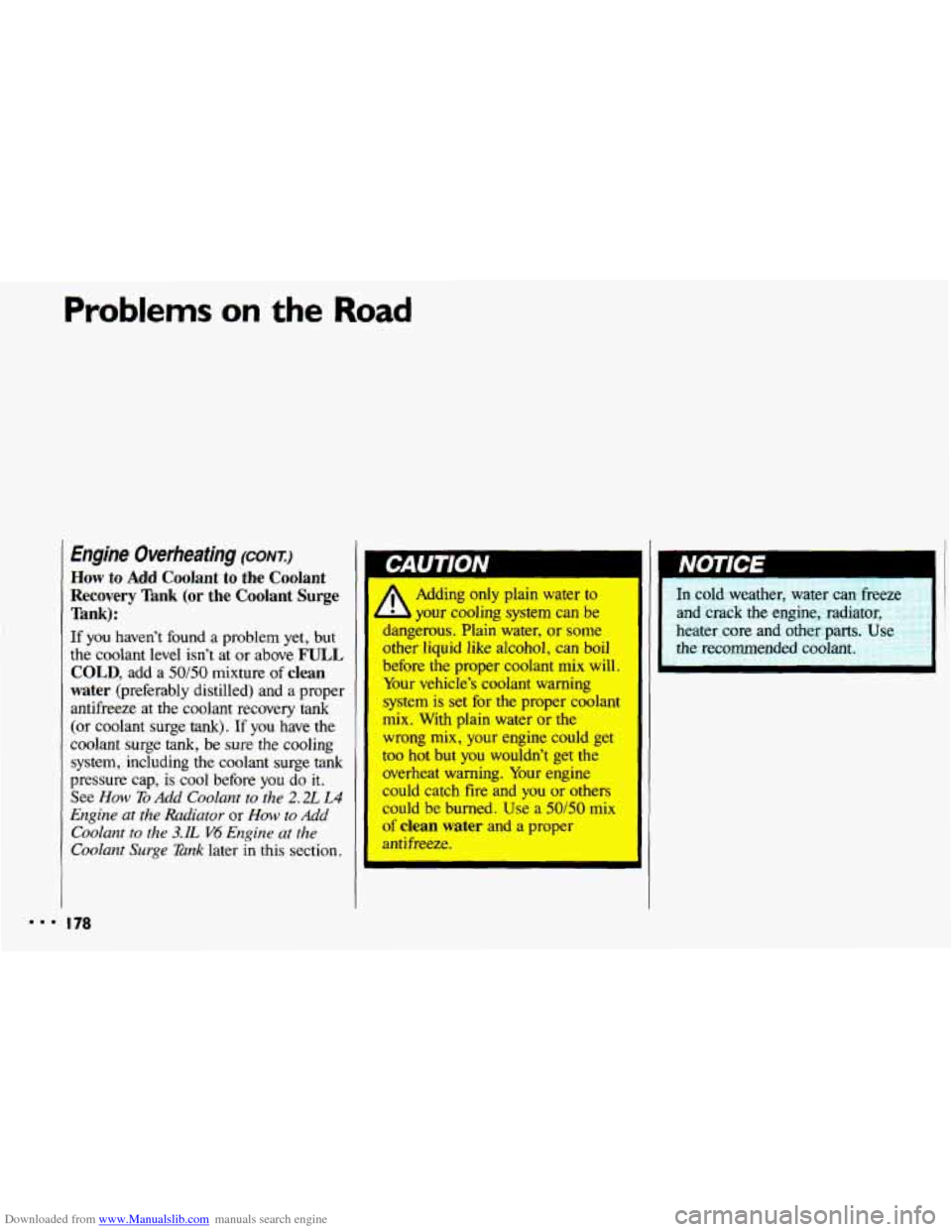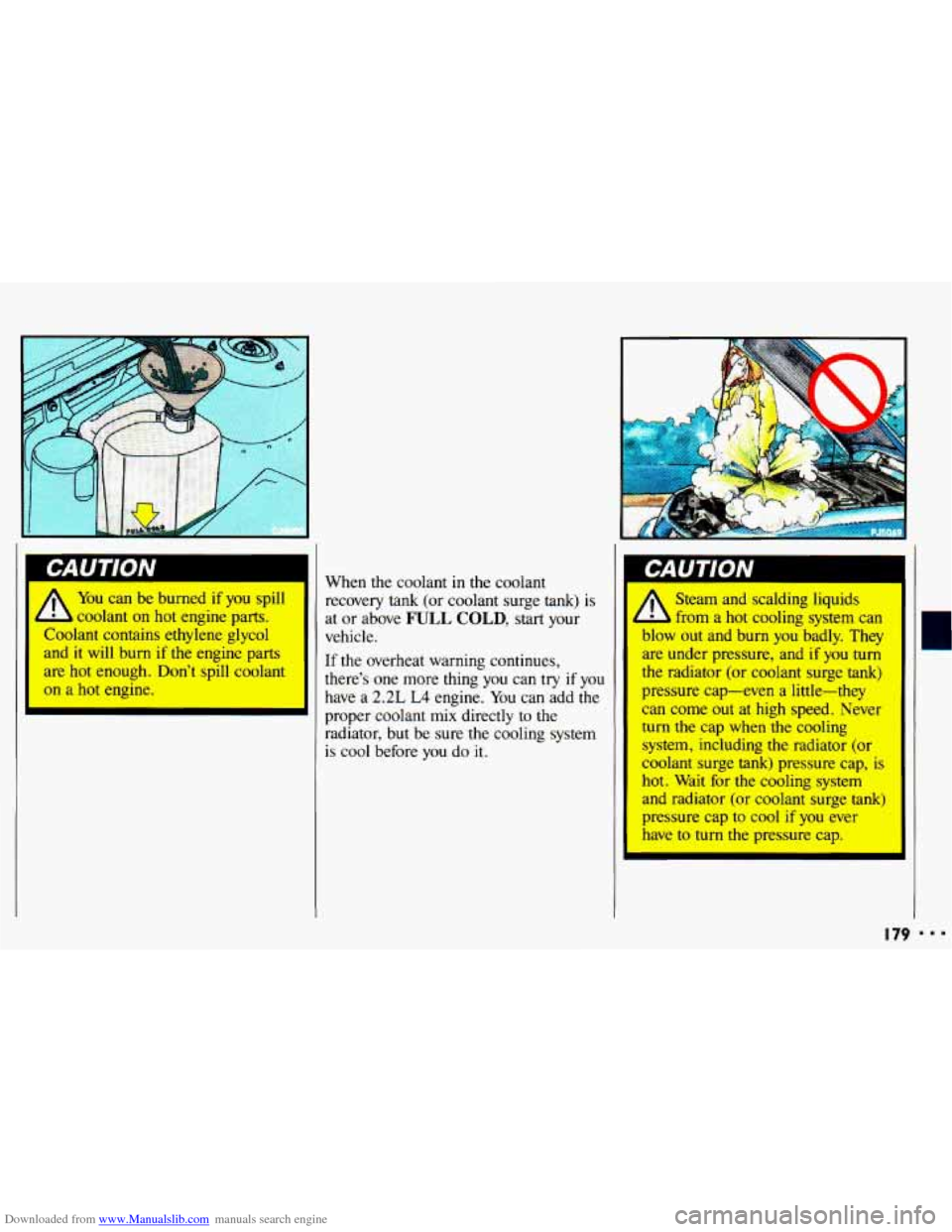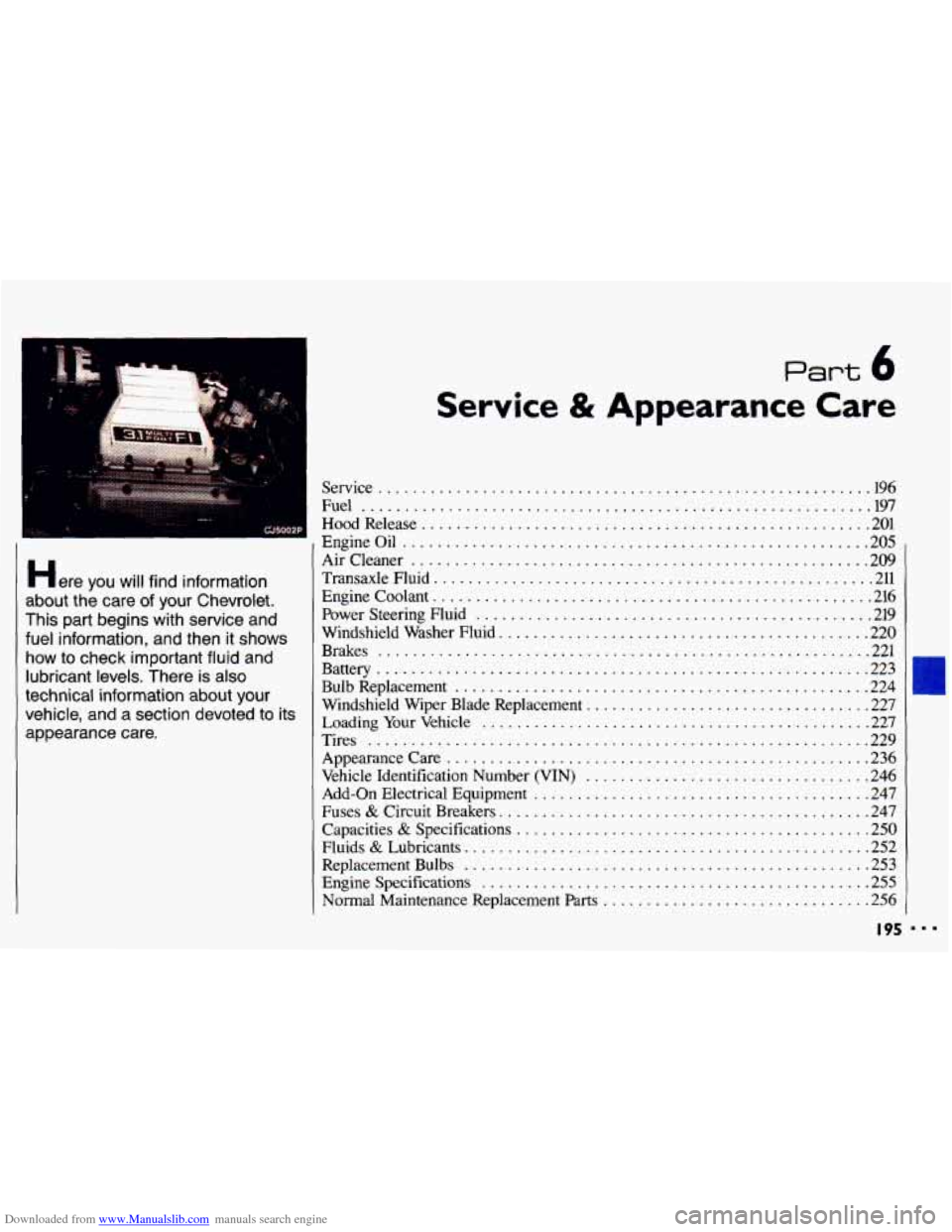Page 179 of 308
Downloaded from www.Manualslib.com manuals search engine The coolant level should be at or above
FULL COLD. If it isn’t, you may have
a leak
in the radiator hoses, heater
hoses, radiator, water pump
or ’
somewhere else in the cooling system.
, Heater and radiator hoses, and
- b other engine parts, can be
very hot. Don’t touch them.
If you
do,
you can be burned.
Don’t run the engine
if there is a
leak.
If you run the engine, it
could lose all coolant. That could
cause
an engine fire, and you could
be burned. Get any leak
fixed
before you drive the vehicle.
Both Engines:
If there seems to be no leak, check to
see
if the electric engine fan is running.
If the engine is overheating, the fan
should be running. If it isn’t, your
vehicle needs service.
I77 I..
Page 180 of 308

Downloaded from www.Manualslib.com manuals search engine Problems on the Road
Engine Overheating (CONT.)
How to Add Coolant to the Coolant
Recovery Tank
(or the Coolant Surge
Tank):
If you haven’t found a problem yet, but
the coolant level isn’t at or above FULL
COLD,
add a 50/50 mixture of clean
water
(preferably distilled) and a proper
antifreeze at the coolant recovery
tank
(or coolant surge tank). If you have the
coolant surge tank, be sure
the cooling
system, including the coolant surge
tank
pressure cap, is cool before you do it.
See How To Add Coolant to the 2.2L L4
Engirze at the Radiator or How to Add
Coolant
to the 3.1L V4 Engine ut the
Coolant
Surge Tank later in this section.
A
Adding only plain water to
your cooling system can be
dangerous. Plain water, or some
other liquid like alcohol, can boil
before the proper coolant mix will.
Your vehicle’s coolant warning
system
is set for the proper cool an^
mix. With plain water or the
wrong
mix, your engine could get
too hot but you wouldn’t get
the
overheat warning, Your engine
could catch fire and you or others
could be burned. Use a 50150 mix
of clean water and a proper
antifreeze. In cold weather, water can freezt
and crack the engine, radiator,
heater core and other parts Ise
the recommended coolant.
mmm I 78
Page 181 of 308

Downloaded from www.Manualslib.com manuals search engine A You can be burned if you spill
coolant on hot engine parts.
Coolant contains ethylene glycol
and
it will burn if the engine parts
are hot enough. Don't spill coolant
on a hot engine. When
the coolant
in the coolant
recovery
tank (or coolant surge tank) is
at or above
FULL COLD, start your
vehicle.
If the overheat warning continues,
there's one more thing you can
try if you
have a
2.2L L4 engine. You can add the
proper coolant mix directly to the
radiator, but be sure the cooling system
is cool before you do
it.
I
A
Steam and scalding liquids
from a hot cooling system can
blow out and burn you badly. They
are under pressure, and
if you turn
the radiator (or coolant surge
tank)
pressure cap-even a little-they
can come out at high speed. Never
turn the cap when the cooling
system, including the radiator (or
coolant surge tank) pressure cap, is
hot. Wait for the cooling system
and radiator (or coolant surge
tank)
pressure cap to cool if you ever
have to turn the pressure cap.
I I 79 I..
Page 182 of 308
Downloaded from www.Manualslib.com manuals search engine Problems on the Road
Engine Overheating (CONE)
How to Add Coolant to the 2.2L LA
Engine at the Radiator: .
1. You can remove the radiator pressure
cap when
the cooling system,
including the radiator pressure cap
and upper radiator hose, is no longer
hot. Turn the pressure cap slowly to
the left until it first stops. (Don’t
press down while turning the
pressure cap.)
If you hear a hiss, wait for that to stop.
A hiss means there is still some pressure
left.
2. Then keep turning the pressure cap, 3. Fill the radiator with the proper mix,
but now push down as
you turn it. up to the base of the filler neck.
Remove the pressure cap.
== 180
Page 183 of 308
Downloaded from www.Manualslib.com manuals search engine 4. Then fill the coolant recovery tank to
FULL COLD.
5. Put the cap back on the coolant
recovery tank, but leave the radiator
pressure cap off. 6. Start the engine and let it run until
you can feel the upper radiator hose
getting hot. Watch
out for the engine
fan.
7. By this time, the coolant level inside
the radiator filler neck may be lower.
If the level is lower, add more of the
proper mix through
the filler neck
until the level reaches the base
of the
filler neck.
I81
Page 184 of 308
Downloaded from www.Manualslib.com manuals search engine Problems on the Road
Engine Overheating (CONT)
8. Then replace the pressure cap. Be
sure the arrows
on the pressure cap
line up like this.
How to Add Coolant to the 3.lL V6
Engine at the Coolant Surge Tank:
1. You can remove the coolant surge
tank pressure cap when the cooling
system, including the coolant surge
tank pressure cap and upper radiator
hose, is
no longer hot. Turn the
pressure cap slowly
to the left until it
first stops. (Don’t press down while
turning the pressure cap.)
If you hear a hiss, wait for that to stop.
A hiss means there is still some pressure
left.
2. Then keep turning the pressure cap,
but now push down
as you turn it.
Remove the pressure cap.
Page 185 of 308
Downloaded from www.Manualslib.com manuals search engine 3. Fill the coolant surge tank with the
proper
mix, up to FULL COLD.
4. With the coolant surge tank pressure
cap
off, start the engine and let it run
until you can feel the upper radiator
hose getting hot. Watch out for
the
engine fan.
By this time, the coolant level inside the
coolant surge tank may be lower. If the
level
is lower, add more of the proper
mix to the coolant surge tank until the
level reaches
FULL COLD.
5. Then replace the pressure cap. Be
sure the arrows on the pressure cap
line up like this.
I83 ...
Page 197 of 308

Downloaded from www.Manualslib.com manuals search engine i
.....
.................................. ...................
........ ... . &5
..... ..... .... .. --
' . I .. ~
Here you wit1 find information
about the care
of your Chevrolet .
This part begins with service and
fuel information. and then
it shows
how to check important fluid and
lubricant levels
. There is also
technical information about your
vehicle. and
a section devoted to its
appearance care
.
Part 6
Service & Appearance Care
Service ......................................................... 196
Fuel ........................................................... 197
HoodRelease
.................................................... 201
EngineOil
...................................................... 205
Aircleaner
..................................................... 209
Transaxle Fluid
................................................... 211
Engine Coolant
................................................... 216
Power Steering Fluid
.............................................. 219
Windshield Washer Fluid
........................................... 220
Brakes
......................................................... 221
Battery
......................................................... 223
BulbReplacement
................................................ 224
Windshield Wiper Blade Replacement
................................. 227
Loading
Your Vehicle ............................................. 227
Vehicle Identification Number (VIN)
................................. 246
Add-on Electrical Equipment
....................................... 247
Fuses
& Circuit Breakers ........................................... 247
Capacities & Specifications ......................................... 250
Fluids & Lubricants ............................................... 252
Replacement Bulbs
............................................... 253
Engine Specifications
............................................. 255
Normal Maintenance Replacement
Parts ............................... 256
Tires .......................................................... 229
Appearancecare
................................................. 236
I95